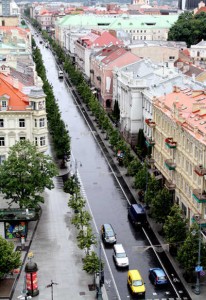- July 7, 2014
- 409
Wandering in the streets of Vilnius: How Mickiewicz ousted Zan

Let’s wander in the streets of Vilnius. The beautiful, distinct, unknown streets named after famous Poles: historian and politician Joachim Lelewel (J. Lelevelio gatvė), writer Józef Ignacy Kraszewski (J. I. Kraševskio gatvė), or composer Stanisław Moniuszko (S. Moniuškos gatvė). Few residents of Vilnius know where they can find the streets named after a poet Juliusz Słowacki (J. Slovackio gatvė), botanist Józef Strumiłło (Juozapo Strumilos gatvė), or oncologist Kazimierz Pelczar (Kazimiero Pelčaro gatvė), probably because these places are located in the suburbs.
Since its foundation, Vilnius has fascinated people. Jesuit, poet, and professor of the Academy of Vilnius Maciej Kazimierz Sarbiewski wrote:
“Thence from the midst o’th’hill all Vilna shall / Our prospect be; our eye shall lower fall— / On Vilia’s cooler streames, that wind, / And with embraces Vilna bind.” (transl. George Hills)
Let’s look in our town for what we don’t know and we may find interesting.
Let’s start with the street named after a poet Adam Mickiewicz (A. Mickevičiaus gatvė). During the interwar period, the street was located between the Cathedral of Vilnius and the Žvėrynas Bridge. It was one of the main streets in the city. Juliusz Kłos, professor of the Stefan Batory University, describes it in his guide book to Vilnius (published in 1937) as follows:
“The big, straight A. Mickevičiaus gatvė, named St. George Avenue (Šv. Georgijaus prospektas) under Russian rule, is loacted near the Cathedral Square. Aside from more or less pretentious tenement houses, you can find there such public buildings worth mentioning as Bank Polski (The Polish Bank), Wileński Prywatny Bank Handlowy (The Vilnius Private Merchant Bank), Wileński Pank Ziemski (The Vilnius Land Bank), Kasyno Oficerskie (The Officers’ Mess), Wileński Dom Towarowo-Przemysłowy Bracia Jabłkowscy (Jabłkowski Brothers’ Department Store), St. George Hotel, the building of the Regional Court, Gimnazjum im. Elizy Orzeszkowej (Eliza OrzeszkowaGymnasium). . .”
You could also find there famous cafés and restaurants, and tenament houses owned by notable residents of Vilnius. Interesting bit of trivia: while named by Russians after St. George, the street bore the name of Gediminas after Lithuania had regained independence in 1918. A year later, it was renamed after Adam Mickiewicz.
During the Soviet occupation, the street was named after Stalin, later renamed after Lenin. Currently, it bears the name of the Grand Duke of Lithuania Gediminas, the founder of Vilnius.
After WWII, in the Soviet Lithuania, Adam Mickiewicz was “sent” to the other side of the bridge, the other side of the Neris. He found himself at the street that was not as important and elegant but very quiet and atmospheric. Little wooden houses with gardens, quiet backyards, a lot of woods – you can find them all in Žvėrynas.
The current A. Mickevičiaus gatvė is loacted near Our Lady of the Sign Church. The church was built by Russians after the Januray Uprising on an acclivity, so it was seen for the whole then-St. George Avenue as its architectonic closure.
After Poland had regained its independence, one of the houses guarded by monuments of knights became a place for residence for Igor Śmiałowski, Polish theatre and film actor, and his parents. He graduated from Joachim Lelewel Gymnasium in Vilnius. Upon graduation, he studied at the Faculty of Fine Arts at Vilnius University and at Vilnius acting school. He died in Warsaw in 2006.
In the interwar period, the street bore the name of Tomasz Zan (T. Zano gatvė), one of Adam Mickiewicz’s closest friends. In 1815, he started studying mathemics and physics at Imperial University of Vilnius. He was a cofounder of the Philomath Society, founder of Związek Promienistych (Radiant Association), head of the Filaret Association, and a member of the Wastrel Society.
Mickiewicz took place of Zan – a coincidence? Zan Street disappeared off the city map. You wouldn’t find the famous library named after him which was located at Wielka Pohulanka; it was Czesław Miłosz’s favourite reading place.
The only things that remind of Zan are the Rasos Cemetery where his son Klemens Zan, father of a Polish poet Kazimiera Iłłakowiczówna, is buried, and the memory of him and his poems.
Justyna Giedrojć
Translated by Michał M. Kowalski within the framework of a traineeship programme of the European Foundation of Human Rights, www.efhr.eu.

